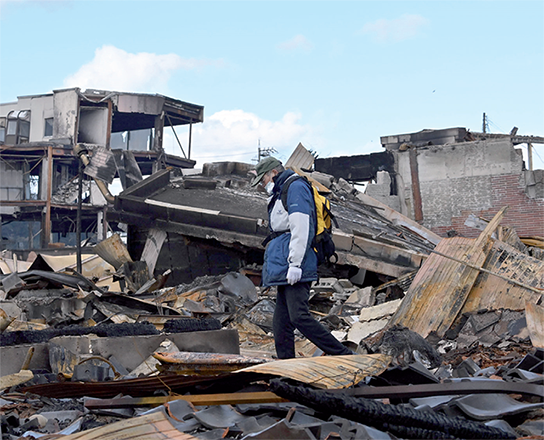You are here
Hopes fade for survivors of Japan quake
By AFP - Jan 04,2024 - Last updated at Jan 04,2024

A man searches for goods on the ruins of his burnt house in the city of Wajima, Ishikawa prefecture on Thursday (AFP photo)
Hundreds of people in more than a dozen communities remained cut off in Ishikawa prefecture in central Japan, devastated by the 7.5-magnitude quake on New Year's Day.
Regional governor Hiroshi Hase told a disaster management meeting that as of 4:00 pm (07:00 GMT), 72 hours after the quake, "the survival rate of those in need of rescue is said to drop precipitously".
"This is the worst catastrophe" in the current Reiwa era in the Japanese calendar, which began in 2019 when the current emperor ascended the throne, Prime Minister Fumio Kishida said.
"Access to this area was extremely difficult, partly due to the geographical constraints of the affected area being a peninsula, and partly due to the intermittent occurrence of major quakes," he said.
"The situation remains difficult, but we will continue to do our utmost to support the victims."
The powerful main tremor, followed by hundreds of aftershocks, injured at least 330 people, local authorities said. Authorities published a list on Thursday of 79 people whose whereabouts were unknown.
With hundreds sleeping in emergency shelters, further scenes of destruction were seen by AFP in the coastal towns of Anamizu and Wajima, including burnt-out cars in a market area ravaged by fire.
Thousands of soldiers, firefighters and police officers from across Japan, assisted by sniffer dogs, combed through the rubble of collapsed wooden houses and toppled commercial buildings for signs of life.
Yasuhiro Morita, working with a rescue unit in Wajima, said that his dog Elza was trained to bark when it finds a body.
“But today, she just wandered off toward bystanders instead, which likely means there was no body inside,” Morita told AFP.
No power
“This is where my grandma’s house used to be, but it’s all burned down,” said Shinichi Hirano, 47.
“She passed away a while ago so her house has long been vacant, but still, this area is full of fond memories for me,” he said.
Military hovercraft delivered heavy construction equipment and vehicles to the devastated port city by sea.
Around 30,000 households were without electricity in Ishikawa on the Sea of Japan coast, and 95,000 homes there and in two neighbouring regions had no water.
Access was blocked to small communities in the hardest-hit Noto Peninsula region — with 300 people desperately waiting for aid at a school in the town of Ooya in the Suzu area.
“Even if I give my food to my children, it is not enough at all. I have eaten almost nothing for the past two days,” a woman in her 30s with three children in Suzu told the Asahi Shimbun newspaper.
‘Critical’ 72 hours
In the city of Nanao, police managing traffic told drivers that one of the main roads leading to Wajima had been prioritised for emergency vehicles.
“Either reconsider carrying on, or risk facing a huge traffic jam ahead,” an officer was heard warning drivers.
At a nearby gas station, a long queue of cars was waiting outside for it to open as the clock ticked past 8am.
Although there were no fuel shortages at the station for now, workers there told AFP they were rationing nonetheless.
Monday’s main shockwave triggered tsunami waves at least 1.2 metres high in Wajima, and a series of smaller tsunamis were reported elsewhere.
Broadcaster NHK reported that one person was swept away by the tsunami in Noto’s Suzu area, with the coastguard investigating.
Japan experiences hundreds of earthquakes every year and most cause no damage, with strict building codes in place for more than four decades.
Earthquakes have hit the Noto region with intensifying strength and frequency over the past five years.
The country is haunted by a massive 9.0-magnitude undersea quake in 2011, which triggered a tsunami that left around 18,500 people dead or missing.
It also swamped the Fukushima atomic plant, causing one of the worst nuclear disasters in history.
Related Articles
WAJIMA, JAPAN — Japanese rescuers battled against the clock and powerful aftershocks on Tuesday to find survivors of a major earthquake that
SHIKA, Japan — The number of people unaccounted for after Japan’s New Year’s Day earthquake more than tripled on Monday to 323 while the dea
WAJIMA, Japan — Japanese rescuers scrambled to search for survivors on Wednesday as authorities warned of landslides from heavy rain after a














